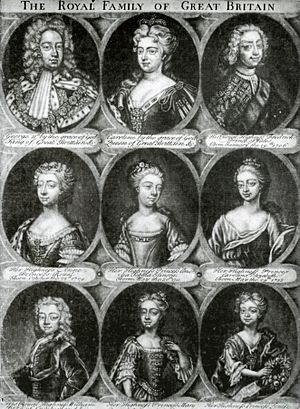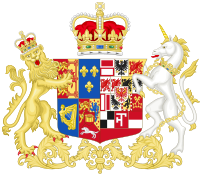Caroline of Ansbach facts for kids
Quick facts for kids Caroline of Ansbach |
|||||
|---|---|---|---|---|---|
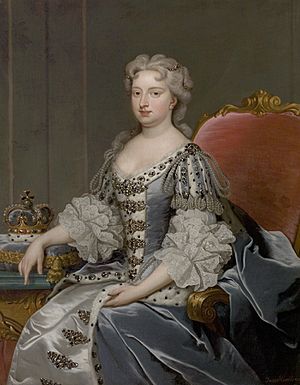
Portrait by Michael Dahl, c. 1730
|
|||||
| Queen consort of Great Britain and Ireland, Electress consort of Hanover |
|||||
| Tenure | 11 June 1727 – 20 November 1737 | ||||
| Coronation | 11 October 1727 | ||||
| Born | 1 March 1683 Ansbach Residence, Principality of Ansbach, Holy Roman Empire |
||||
| Died | 20 November 1737 (aged 54) St James's Palace, London, Great Britain |
||||
| Burial | 17 December 1737 Westminster Abbey, London |
||||
| Spouse | |||||
| Issue | |||||
|
|||||
| House | Hohenzollern | ||||
| Father | John Frederick, Margrave of Brandenburg-Ansbach | ||||
| Mother | Princess Eleonore Erdmuthe of Saxe-Eisenach | ||||
Caroline of Brandenburg-Ansbach (born Wilhelmina Charlotte Caroline; 1 March 1683 – 20 November 1737) was the Queen of Great Britain and Ireland. She was also the Electress of Hanover. She held these titles from 1727 until her death in 1737. She was the wife of King George II.
Caroline's father, Margrave John Frederick of Brandenburg-Ansbach, was a ruler of a small German state. This state was called the Principality of Ansbach. When Caroline was young, she became an orphan. She then moved to the court of her guardians, King Frederick I and Queen Sophia Charlotte of Prussia. At the Prussian court, her education improved greatly. She learned to think openly, like Sophia Charlotte. Sophia Charlotte became her good friend and influenced Caroline throughout her life.
As a young woman, many wanted to marry Caroline. She turned down a proposal from Archduke Charles of Austria. She then married George Augustus. He was third in line to the English throne. He was also the future ruler of Hanover. They had eight children together. Seven of them grew up to be adults. Caroline moved to Britain in 1714. Her husband became Prince of Wales. As Princess of Wales, she and her husband opposed his father, King George I. In 1717, her husband was sent away from court after a family argument. Caroline became friends with Robert Walpole, a politician. Walpole later rejoined the government. Caroline's husband and King George I made up publicly. This happened because Walpole advised them to. Walpole soon became the most important minister.
When her husband became king in 1727, Caroline became queen. Her oldest son, Frederick, became Prince of Wales. He also opposed his father, just like his father had done. Caroline's relationship with him was difficult. As princess and queen, Caroline was known for her political power. She used this power to help Walpole. She was regent four times when her husband was in Hanover. She helped make the House of Hanover stronger in Britain. This was a time when politics were very unstable. After she died in 1737, many people missed her. This included her political friends and the King. The King never remarried after her death.
Contents
Early Life and Education
Caroline was born on March 1, 1683, in Ansbach. Her parents were John Frederick, Margrave of Brandenburg-Ansbach, and his second wife, Princess Eleonore Erdmuthe of Saxe-Eisenach. Her father ruled one of the smallest German states. He died from smallpox when he was 32. Caroline was only three years old at the time. Caroline and her younger brother, William Frederick, moved with their mother to her home in Eisenach.
In 1692, Caroline's mother married again. She married the Elector of Saxony. Her mother and the children moved to the Saxon court in Dresden. Caroline's mother became a widow again two years later. Her husband died from smallpox. Eleonore stayed in Saxony for two more years. She died in 1696. Caroline and William Frederick were now orphans. They went back to Ansbach to live with their older half-brother, Margrave George Frederick II. He was young and not interested in raising a girl. So, Caroline soon moved to Lützenburg, near Berlin. There, she was cared for by her new guardians. They were Frederick, Elector of Brandenburg, and his wife, Sophia Charlotte. Sophia Charlotte had been a friend of Caroline's mother.
Learning and Growth
Frederick and Sophia Charlotte became king and queen of Prussia in 1701. The Queen was known for being very smart and strong. Her court was open-minded and welcomed many thinkers. One famous person was the philosopher Gottfried Leibniz. Caroline experienced a lively and intellectual world. This was very different from what she knew before. Before living with Sophia Charlotte, Caroline had little formal schooling. Her handwriting was never very good. But with her bright mind, Caroline became a very skilled learner. She and Sophia Charlotte became very close. Sophia Charlotte treated Caroline like her own daughter. The Queen once said Berlin felt "a desert" without Caroline.
Marriage and Family Life
Caroline was smart and attractive. Many people wanted to marry her. Dowager Electress Sophia called her "the most agreeable Princess in Germany." She was considered for marriage to Archduke Charles of Austria. He was a possible king of Spain and later became a Holy Roman Emperor. Charles asked her to marry him in 1703. King Frederick of Prussia encouraged this match. But Caroline refused in 1704. She did not want to change from Lutheranism to Catholicism. The next year, Queen Sophia Charlotte died. Caroline was very sad. She wrote to Leibniz that she was filled with "grief and sickness."
In June 1705, Queen Sophia Charlotte's nephew visited Ansbach. This was Prince George Augustus of Hanover. He came secretly to meet Caroline. His father did not want him to have a marriage without love. George Augustus needed to marry and have children. This was important for the Hanoverian family line. He had heard that Caroline was "incomparably beautiful and smart." He liked her "good character" right away. The British messenger said George Augustus "would not think of anybody else." Caroline knew who he was, even though he was disguised. She found him attractive. He was the future ruler of Hanover. He was also third in line to the English throne.
On August 22, 1705, Caroline arrived in Hanover for her wedding. They married that evening in the palace chapel. By May of the next year, Caroline was expecting a baby. Her first child, Prince Frederick, was born on January 20, 1707. A few months later, Caroline became very ill. She had smallpox and then pneumonia. Her baby was kept away from her. But George Augustus stayed by her side. He also caught the infection. Both of them got better. Over the next seven years, Caroline had three more children. They were Anne, Amelia, and Caroline. All of them were born in Hanover.
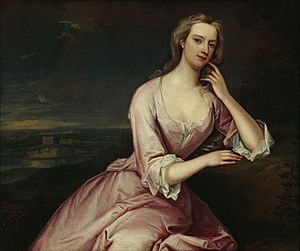
George Augustus and Caroline had a happy and loving marriage.
After England and Scotland united in 1707, the family's right to the British throne was confirmed. But it was not completely safe. Queen Anne's half-brother, James Stuart, also claimed the throne. Queen Anne and Caroline's grandmother-in-law, Dowager Electress Sophia, had a disagreement. Anne did not allow any of the Hanoverian family to visit Britain while she was alive. Caroline wrote to Leibniz about this. In June 1714, Dowager Electress Sophia died at 83. She died in Caroline's arms. Caroline's father-in-law then became Queen Anne's heir. Just weeks later, Anne died. The Elector of Hanover became the new king, George I of Great Britain.
Princess of Wales and Royal Life
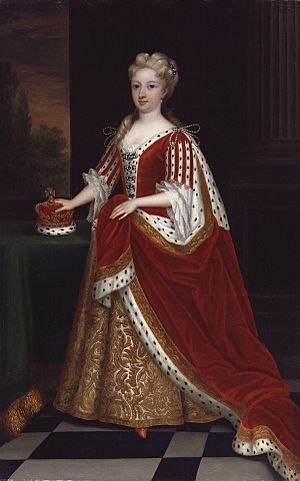
George Augustus sailed to England in September 1714. Caroline and two of her daughters followed in October. Her trip across the North Sea was the only sea journey she ever took. Their young son, Prince Frederick, stayed in Hanover. He was raised by tutors.
When George I became king in 1714, Caroline's husband became Duke of Cornwall and Duke of Rothesay. Soon after, he became Prince of Wales. Caroline then became Princess of Wales. She was the first woman to get this title at the same time as her husband. She was also the first Princess of Wales in over 200 years. The last one was Catherine of Aragon. Since George I's marriage had ended before he became king, there was no queen. This meant Caroline was the most important woman in the kingdom. George Augustus and Caroline tried hard to become more "English." They learned the language, met people, and understood the politics.
Two different courts grew. The old king's court had German people and ministers. The Wales's court attracted English nobles. These nobles were not favored by the King. The Wales's court was more popular with the British people. George Augustus and Caroline slowly became leaders of the political opposition to the King.
Two years after coming to England, Caroline had a stillbirth. The next year, she had another son, Prince George William. At his baptism, her husband argued with his father. This was about who would be the godparents. The couple was put under house arrest. Then they were sent away from court. Caroline was first allowed to stay with her children. But she refused, believing she should be with her husband. She and her husband moved to Leicester House. Their children stayed with the King. Caroline worried a lot and became sick. She fainted during a secret visit to her children. By January, the King allowed Caroline to see her children freely. In February, Prince George William became ill. The King let both George Augustus and Caroline see him. When the baby died, doctors checked to make sure it was from illness. They wanted to prove it was not because he was separated from his mother.
More sadness came in 1718. She had a miscarriage after a bad storm. Over the next few years, Caroline had three more children: William, Mary, and Louise. In July 1725, her last pregnancy ended in another miscarriage.
Leicester House became a place for politicians who opposed the government. Caroline became friends with Sir Robert Walpole. He was a former minister who led a group of unhappy politicians. In April 1720, Walpole's group made up with the government. Walpole and Caroline helped the King and her husband make peace. This was for the good of the public. Caroline wanted her three oldest daughters back. They were still with the King. She thought the peace would help. But it did not work out. George Augustus thought Walpole had tricked him. The prince became politically alone. Leicester House then became a place for writers and smart people.
Caroline was much smarter than her husband. She loved to read. She built a large library at St James's Palace. When she was young, she wrote letters to Gottfried Leibniz. He was a very famous thinker. She later helped with the Leibniz–Clarke correspondence. This was an important discussion about physics. She also helped make variolation popular. This was an early way to prevent smallpox. Caroline had six prisoners try variolation instead of being executed. They all lived. Six orphan children also had the treatment and survived. Caroline was convinced it worked. She had her children Amelia, Caroline, and Frederick inoculated against smallpox. Voltaire praised her for supporting smallpox prevention. He said she was a "benevolent philosopher" even on the throne.
Becoming Queen and Regent

Caroline became queen when her father-in-law died in 1727. She was crowned with her husband at Westminster Abbey on October 11 that year. George II did not like Walpole at first. But Caroline told her husband to keep Walpole as the main minister. Walpole had many supporters in Parliament. George II had to accept him or risk problems in the government. Walpole made sure Caroline received £100,000 a year. She also got Somerset House and Richmond Lodge. Lord Hervey called Walpole "the Queen's minister." This showed how close they were. For the next ten years, Caroline had a lot of power. She convinced the King to follow Walpole's plans. She also stopped Walpole from doing things that would cause trouble. Caroline believed in open ideas. She supported mercy for the Jacobites. These were people who supported the rival House of Stuart family. She also supported freedom of the press and free speech in Parliament.
For many years, she and her husband argued with their oldest son, Frederick, Prince of Wales. He had stayed in Germany when they came to England. He joined the family in 1728. By then, he was an adult with debts. He liked gambling and playing jokes. He disagreed with his father's politics. He complained about not having enough power in government. The Regency Act 1728 made Caroline the regent. This meant she ruled when her husband was away. He was in Hanover for five months in 1729. During her time as regent, a problem with Portugal was solved. A British ship had been taken. Also, a peace agreement was made between Britain and Spain. From May 1732, she was regent for four months again. This was while George II was in Hanover. An investigation into prisons found many problems. There was cruel treatment and help for rich prisoners to escape. Caroline pushed Walpole to make changes. But she was not very successful. In March 1733, Walpole suggested a new tax law. The Queen supported it. But it was so unpopular that it was dropped.
Caroline spent her whole life in Britain in or near London. As queen, she continued to be around artists, writers, and thinkers. She collected jewelry, especially cameos and intaglios. She also bought important portraits and small paintings. She enjoyed visual arts. She ordered clay busts of English kings and queens. She also oversaw the design of the royal gardens. These gardens were made to look more natural. In 1728, she found drawings by Leonardo da Vinci and Hans Holbein. These had been hidden since the time of William III.
Caroline's oldest daughter, Anne, married William IV, Prince of Orange in 1734. She moved with her husband to the Netherlands. Caroline wrote to her daughter about her "indescribable" sadness. Anne soon missed home. She came back to England when her husband went to fight. Eventually, her husband and father told her to go back to Holland.
Final Years and Legacy
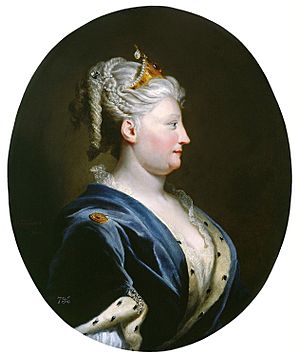
In 1735, Frederick, Prince of Wales, was upset again. Caroline, not him, was regent while the King was away. The King and Queen arranged Frederick's marriage in 1736. He married Princess Augusta of Saxe-Gotha. Soon after the wedding, George went to Hanover. Caroline became "Protector of the Realm" again. As regent, Caroline thought about pardoning Captain John Porteous. He had been found guilty of murder in Edinburgh. Before she could act, a crowd broke into the jail. They killed him. Caroline was shocked. The King's trips abroad were making him unpopular. In late 1736, he planned to return. But his ship was caught in bad weather. People rumored he was lost at sea. Caroline was very sad. She was also disgusted by her son. He hosted a big dinner while the storm was blowing. During her time as regent, the Prince of Wales tried to argue with his mother. He saw her as a way to annoy the King. George finally returned in January 1737.
Frederick asked Parliament for more money. The King had refused him this before. The public argument about money caused more problems between parents and son. Walpole advised raising Frederick's money. This was to stop more conflict. But it was less than he asked for. In June 1737, Frederick told his parents Augusta was pregnant. She was due in October. But Augusta's due date was earlier. In July, the prince found his wife was in labor. He secretly took her out of Hampton Court Palace in the middle of the night. He wanted to make sure the King and Queen could not be there for the birth. George and Caroline were horrified. Usually, royal births were seen by family and important people. This was to make sure the baby was truly royal. Augusta had been forced to ride in a bumpy carriage for an hour and a half. She was very pregnant and in pain. The Queen, with her daughters and Lord Hervey, rushed to St James's Palace. Frederick had taken Augusta there. Caroline was relieved to find Augusta had given birth to a "poor, ugly little she-mouse." This baby was also named Augusta. The baby's weak state made it unlikely she was a fake child. The way the birth happened made the mother and son even more distant.
In her last years, Caroline had gout in her feet. More seriously, she had an umbilical hernia from her last child's birth in 1724. On November 9, 1737, she felt a sharp pain. After struggling through a formal event, she went to bed. Part of her small intestine had pushed through the hernia. For the next few days, she had medical treatments. But she did not get better. The King did not let Frederick see his mother. She agreed with this. She sent her son a message of forgiveness through Walpole. She asked her husband to remarry after she died. He said he would only have mistresses. She replied, "My God, that doesn't prevent it." On November 17, her bowel burst. She died on November 20, 1737, at St James's Palace.
She was buried in Westminster Abbey on December 17. Frederick was not invited to the funeral. George Frideric Handel wrote a song for the occasion. It was called The Ways of Zion Do Mourn / Funeral Anthem for Queen Caroline. The King arranged for two matching coffins. They had sides that could be removed. This was so they could lie together when he died 23 years later.
Queen Caroline's Impact

Many people were sad when Caroline died. Protestants praised her good example. Even the Jacobites, who opposed the King, recognized her kindness. During her life, she refused to change her religion. This was when she was offered marriage to Archduke Charles. This showed her strong belief in Protestantism. For example, John Gay wrote about Caroline in 1714:
- The pomp of titles easy faith might shake,
- She scorn'd an empire for religion's sake:
- For this, on earth, the British crown is giv'n,
- And an immortal crown decreed in heav'n.
People widely believed she had great influence over her husband. A funny poem from that time said:
- You may strut, dapper George, but 'twill all be in vain,
- We all know 'tis Queen Caroline, not you, that reign –
- You govern no more than Don Philip of Spain.
- Then if you would have us fall down and adore you,
- Lock up your fat spouse, as your dad did before you.
Writings from the 1700s, especially by John, Lord Hervey, made people think Caroline and Walpole controlled her husband. Historians in the 1800s and 1900s said she helped the House of Hanover become strong in Britain. This was despite the Jacobite opposition. R. L. Arkell wrote that Caroline "ensured the dynasty's rooting itself in England." William Henry Wilkins said her "gracious and dignified personality" helped make her husband and father-in-law more popular. Modern historians think her importance might have been a bit exaggerated. But it is still likely that Caroline of Ansbach was one of the most influential queens in British history.
Titles and Honors
Titles and Styles
- 1683–1705: Her Serene Highness Princess Caroline of Brandenburg-Ansbach
- 1705–1714: Her Serene Highness The Electoral Princess of Hanover
- 1714–1727: Her Royal Highness The Princess of Wales
- 1727–1737: Her Majesty The Queen
Honors and Namesakes
Caroline County in the British Colony of Virginia was named after her. This happened when it was formed in 1727.
Coat of Arms
Caroline's coat of arms combined the royal arms of the United Kingdom with her father's arms.
| Queen Caroline's coat of arms: the royal arms of the United Kingdom (on the right side) combined with her father's arms |
Children of Queen Caroline
Caroline had ten or eleven pregnancies. Eight children were born alive. One died as a baby. Seven lived to be adults.
| Name | Birth | Death | Notes |
|---|---|---|---|
| Frederick, Prince of Wales | 31 January 1707 | 31 March 1751 | married 1736, Princess Augusta of Saxe-Gotha; had children, including the future George III |
| Anne, Princess Royal | 2 November 1709 | 12 January 1759 | married 1734, William IV, Prince of Orange; had children |
| Princess Amelia | 10 June 1711 | 31 October 1786 | |
| Princess Caroline | 10 June 1713 | 28 December 1757 | |
| Stillborn son | 20 November 1716 | ||
| Prince George William | 13 November 1717 | 17 February 1718 | died as a baby |
| Miscarriage | 1718 | ||
| Prince William, Duke of Cumberland | 26 April 1721 | 31 October 1765 | |
| Princess Mary | 5 March 1723 | 14 January 1772 | married 1740, Frederick II, Landgrave of Hesse-Kassel; had children |
| Princess Louisa | 18 December 1724 | 19 December 1751 | married 1743, Frederick V, King of Denmark and Norway; had children |
| Miscarriage | July 1725 | ||
|
|
|||
See also
 In Spanish: Carolina de Brandeburgo-Ansbach para niños
In Spanish: Carolina de Brandeburgo-Ansbach para niños



